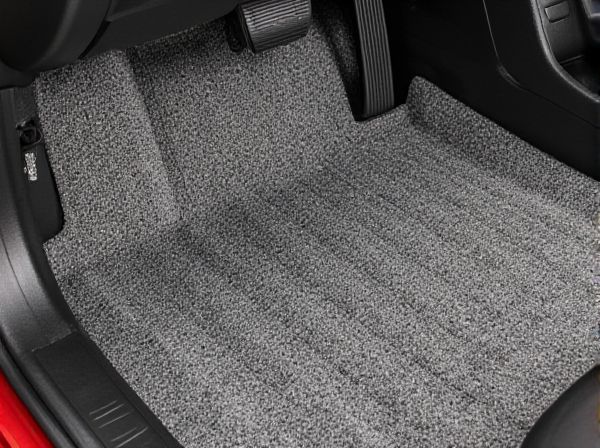
Photo illustration: Tufted vs Woven
Tufted rugs are created by punching yarn into a fabric backing, offering a softer texture and often more vibrant patterns. Woven rugs are crafted by interlacing warp and weft threads, resulting in a durable and tightly constructed surface ideal for high-traffic areas. Understanding the differences helps you choose the best rug type for your style and functional needs.
Table of Comparison
| Feature | Tufted Car Carpet | Woven Car Carpet |
|---|---|---|
| Manufacturing | Yarn is punched into a backing material | Yarn is interlaced on a loom |
| Durability | Moderate; prone to wear in high-traffic areas | High; tightly woven and resistant to abrasion |
| Cost | Lower cost, budget-friendly | Higher cost, premium quality |
| Appearance | Varied textures and colors, less refined | Smoother, more uniform surface with intricate patterns |
| Maintenance | Easy to clean, but may trap dirt | Harder to clean but more stain-resistant |
| Comfort | Soft feel | Firm and supportive |
Introduction: Tufted vs Woven Rugs
Tufted rugs feature loops of yarn pushed through a backing material, creating a plush, textured surface ideal for durability and affordability. Woven rugs are crafted by interlacing warp and weft threads on a loom, offering intricate patterns and superior craftsmanship that enhance longevity. Choosing between tufted and woven rugs depends on desired aesthetics, texture preferences, and budget constraints.
What is a Tufted Rug?
A tufted rug is created by inserting yarn into a fabric backing using a needle or tufting gun, producing a soft, textured surface with various pile heights and patterns. This method allows for faster production and more affordable rugs compared to woven techniques. Tufted rugs typically feature a backing made of latex or cotton to secure the fibers and enhance durability.
What is a Woven Rug?
A woven rug is crafted by interlacing warp and weft threads on a loom, producing a tight, durable fabric with intricate patterns and textures. Unlike tufted rugs that use needle punching or threading techniques, woven rugs often feature detailed designs woven directly into the fabric, enhancing longevity and aesthetic appeal. Common weaving methods include flatweave, kilim, and tapestry, each contributing unique styles and qualities to the rug's finished look.
Key Differences Between Tufted and Woven Rugs
Tufted rugs are created by pushing yarn through a pre-made backing fabric using a tufting gun, resulting in faster production and more affordable pricing, whereas woven rugs are handcrafted by interlacing warp and weft threads on a loom, offering superior durability and intricate designs. Tufted rugs typically have a stiffer backing and may require a rug pad to prevent slipping, while woven rugs often have a more flexible and natural backing that lies flatter on floors. The pile height in tufted rugs can vary more, providing plush textures, whereas woven rugs tend to have a flatter, thinner pile, making them ideal for high-traffic areas.
Durability: Which Lasts Longer?
Tufted carpets, created by inserting yarn into a backing fabric, typically offer moderate durability suitable for residential use but may wear faster in high-traffic areas compared to woven carpets. Woven carpets, constructed by interlacing warp and weft threads, are known for their exceptional durability and strength, making them ideal for commercial spaces and heavy foot traffic. The dense fiber construction and tight weave in woven carpets contribute to their longer lifespan and resilience against wear and tear.
Design and Pattern Possibilities
Tufted rugs offer greater design versatility with intricate patterns and a wide range of colors due to their construction process using punched yarn into a fabric backing. Woven rugs provide more precise, detailed designs with sharper patterns and complex motifs thanks to the interlacing of warp and weft threads. The choice between tufted and woven impacts the intricacy, texture, and durability of rug patterns, influencing overall aesthetic appeal.
Comfort and Texture Comparison
Tufted carpets offer a soft and cushiony texture due to their looped or cut pile construction, enhancing comfort underfoot with a plush feel. Woven carpets, created by interlacing warp and weft threads, provide a denser and more durable surface that maintains firmness while delivering a smooth texture. The choice between tufted and woven impacts overall comfort as tufted styles prioritize softness, while woven options emphasize resilience and a refined tactile experience.
Maintenance and Cleaning Requirements
Tufted carpets typically require more frequent vacuuming due to their looser pile structure, which can trap dirt and debris more easily than woven carpets. Woven carpets, known for their dense and tightly constructed fibers, tend to resist wear and stains better, making them easier to maintain with less frequent deep cleaning. Spot cleaning and professional cleaning intervals vary, but woven carpets generally hold up longer under heavy foot traffic with minimal maintenance.
Price and Value Considerations
Tufted rugs generally offer a more budget-friendly option due to faster production methods, appealing to cost-conscious buyers seeking style without high expense. Woven rugs, crafted with intricate techniques and durable fibers, typically command higher prices but provide superior longevity and value over time. Investing in woven rugs can result in better long-term cost efficiency through enhanced durability and timeless craftsmanship.
How to Choose: Tufted or Woven Rug?
Tufted rugs offer a cost-effective option with faster production and a softer texture, making them ideal for casual or high-traffic areas, while woven rugs provide exceptional durability and intricate designs suited for formal settings or areas needing long-lasting wear. Consider the rug's location, expected foot traffic, maintenance requirements, and aesthetic preferences when deciding between tufted and woven options. Prioritize woven rugs for heirloom quality and detailed patterns, whereas tufted rugs work well for affordable style and versatility.
 caratoz.com
caratoz.com